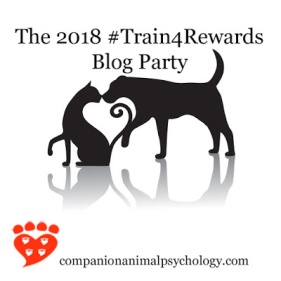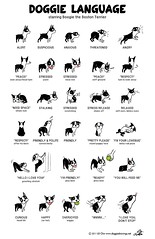Behavior Shaping Game (for Humans)
[long nerdy post warning]

I am very lucky to have inspiring professional dog trainers in my life who help me be a better dog geek and parent. When my dog trainer friend Sarah Owings asked if I wanted to playtest a “Tabletop Shaping Game” as her lab rat, my answer was YES YES YES.
Sarah’s game is a version of a behavior shaping game (for humans) developed many years ago by renowned UK dog trainer Kay Laurence, to help dog trainers become better trainers. When our dogs fail to learn something, make mistakes, or get frustrated, this is usually because something in the training plan isn’t working. The games are for trainers to hone their skills in testing, refining, and fixing their training plans. The learner or the dog is never blamed or punished.
There is also a variant of this game called PORTL (portable operant research teaching laboratory) that is used by the University of North Texas for research into Behavior.
In Sarah’s version of the game:
- There is 1 Teacher and 1 Learner
- The game is played with objects on a table, a clicker, and reinforcers. (reinforcers/”treats” are represented by small objects – there are a few different kinds) The Learner chooses their reinforcer before the start of the game.
- Each mini-session is short – 10 reinforcers per session. We work on ONE goal at a time.
- Click + reinforcer = Learner is to repeat the behavior. No click = try something else.
- There is no talking while the Learner is working.
- Each player takes notes at the end of each session and there is discussion at the end of the game. Was the Learner Happy? Confused? Thoughtful? Frustrated?
My partner Nathan, and I both took turns being the Teacher and the Learner. In between the sessions, Sarah privately instructed the Teacher what to do. I can’t go into all the details of the game we played because this would be like publishing spoilers and ruining it for everyone, but I will share general insights from MY experience.
It was interesting to FEEL what it’s like being the “dog” and learning about how Nathan and I learn differently!
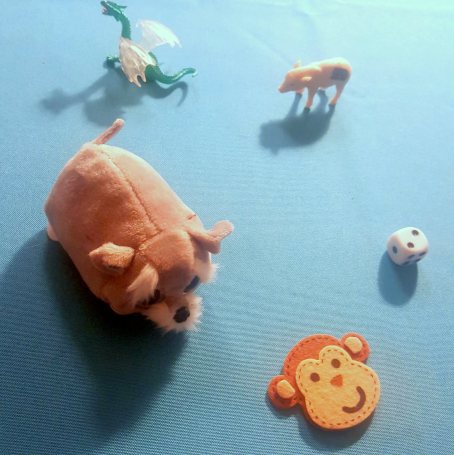
GAME 1: Nathan trains me to Flip His Monkey (not a euphemism).
The goal was to allow me to explore the objects on the table and then Nathan was to strengthen ONE behavior with added reinforcement (Click & R+).
Sarah gave an example: “the way a dog might initiate jumping up behavior at the door, then get reinforced for it by humans looking down, talking to him, pushing him down, and doing other exciting things in response.“
I personally don’t have any issue with Boogie jumping up, but here’s a reinforced behavior I know too well.
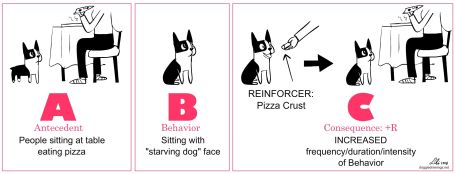
When I touched the monkey head on the table, he CLICKED and gave me a “treat”. None of the other objects on the table earned me a click. I learned quickly that the target behavior had to do with the Monkey. Every time I touched the Monkey, I received a Click and R+ so I kept touching the Monkey.

Observations:
- One time Nathan clicked when I did something different (put the Monkey on the Frog), so I repeated the different behavior, and when I didn’t receive a click, I was momentarily confused. Later, I read his notes and he had written “I screwed up” – he had accidentally clicked a behavior he didn’t mean to click. It wasn’t a big deal because I was being clicked many times afterwards for doing the correct behavior.

- At the end of the game, when Nathan and I compared notes, I had circled “Happy” and “Thoughtful/Focused” on my sheet of paper, but according to Nathan, I seemed frustrated like I wanted MORE. “You wanted to build something with ALL the objects on the table”. This was true – after being clicked 30 times for repeatedly picking up and flipping the Monkey, I was bored and had started interacting with the other objects on the table to see if there was something else that could earn me clicks.
- In the 3rd session, the other objects had been removed from the table so it was clear that I had to interact only with the Monkey.
Sarah: “We learned that you are a learner that enjoys novelty, puzzles, more interesting challenges–those types of actions are more reinforcing for you than simply getting the right answer. This is what I love best about training. Ever when the teacher’s plans go awry, if you listen to what your learner is telling you, you learn how to teach that learner better in the future.”
GAME 2: Lili trains Nathan to Put His Finger in my Scrunchie (also not a euphemism)

There was a Scrunchie on the table – no other objects present – and the goal was to have Nathan put his finger in the Scrunchie- and he took to it so quickly – only after 2 clicks, that Sarah instructed me to put this behavior on cue in the next session.
My cue was a card with a yellow diamond on it.

Sarah: “The order here is very important…First you hold up the cue card…THEN you moved the scrunchie in front of him…behavior…Click R+. Not the other way around”
When Nathan got it right very quickly, my next goal was to teach Stimulus Control. ie, Nathan should put his finger in the scrunchie when I give the cue. When I don’t give the cue, he shouldn’t put his finger in the scrunchie.
Here was something new to me – first of all, I had to establish a Off-Cue Behavior (in this case, eye contact from Nathan) that I could also click and treat. The goal with having Off-Cue and On-Cue Behaviors is to to reduce learner errors and/or frustration and keep the rate of reinforcement up. The Learner will always get reinforced for something, and no punishment or extinction is necessary.

In contrast, an illustration of what Negative Punishment (= removing something to prevent behavior from recurring) would look like, which can make the Learner shut down or hesitate to keep playing, or feel frustrated if they didn’t get the Cue to begin with.
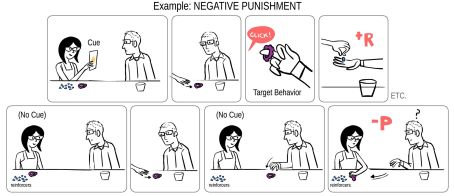
Observations:
- When I first held up the cue card, Nathan stopped. He stared at the card for a long time before picking up the scrunchie. Later, he told us he saw the yellow card as “a penalty card” like in soccer, so he had immediately interpreted this as a NO signal. This was a great example of Learners bringing past experiences to the table.
Sarah said – Imagine teaching a dog a new cue for SIT which is a hand signal (she lowered her hand with palm faced down), and what if in a previous home this is the same hand signal the dog would see before every time he got hit.
The cue that we think is neutral, may not be neutral for this individual dog. It may have other negative associations of which we are not aware. It’s important to pay attention/listen to our individual Learner so we can choose our cues with care, and train accordingly.
- When I was training the Off-Cue Behavior, (no cue card) I started with no scrunchie on the table, and added this back later. The very first time that I added the scrunchie back in front of Nathan with no cue, he stared at it for a long while. He then picked up the scrunchie and put his finger in it, and when I didn’t click, he put it back down and looked at me like he knew he shouldn’t have done that. This was actually MY mistake. I changed the criteria, added the distraction, and should have clicked when he first got it right, instead of waiting for a different behavior.
Sarah: “Clicking just for holding still for half a second, with hands in lap, would have ensured that he NOT interact with it on the first round and cemented the information that sitting still was correct. Instead, you waited a long time, waiting for eye contact. Eventually he was not sure about what you wanted and made a mistake–putting the scrunchie on his finger off-cue. But Nathan’s one error was informative for him. He interacted with the scrunchie–no click. He put it down and looked at you. You presented the cue–back on track. You made good teaching choices there.”
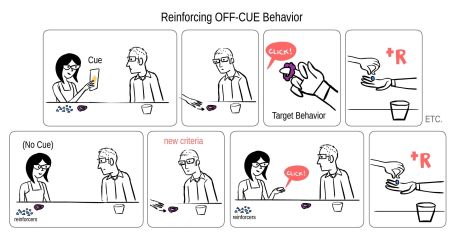
In 40 repetitions, Nathan made a (off-cue behavior) mistake only ONCE. That was pretty good, I thought. 🙂
Also for some reason, whenever Nathan gave me eye-contact he would burst into laughter which then made me laugh. The more I clicked this eye-contact, the session turned into a laugh-fest. We could both circle “Happy” on our review sheets.
To summarize, these Behavior Shaping Games were a fun and fascinating way to experience how operant conditioning works, the power of clear non-verbal communication, and individual learning styles.
Most importantly, I got a sense of what it might feel like to be a dog being trained by a human-trainer, (Sorry, Boogie. I have so much more empathy for you, now!) and a much clearer sense that there are two individuals involved in this training game.
I think Nathan was a better Learner – he was way more focused with his attention. I was more all over the place as a Learner and got bored even without realizing I got bored until this was pointed out to me later.
To those “Obedience” people who dismiss Positive Reinforcement training as something like “bribery” or “spoiling the dog” – this couldn’t be further from the truth. When done well, I see R+ training is an admirable skill and demonstrates good planning, good timing, an ability to read your learner and change your training plan to help them succeed and not be frustrated. There is so much brain and heart in this approach to training.
Thank you, Sarah!
P.S. Boogie is deaf in his old age, so I no longer use the clicker or any verbal cues. I use a “thumbs up” for a click/yes.
RELATED:
Check out this amazing video by expert trainer Mary Hunter. It’s super advanced but offers a great example of training/shaping without using words, planned in such a way that the learner gets it right 100% of the time. (This blog post by Mary Hunter is also worth reading: When Teaching Doesn’t Equal Learning)
2017 Book List

- What The Dog Knows is the story of a German Shepherd who becomes a professional cadaver dog. Absolutely fascinating if you are interested in how sniffer dogs are trained. With pieces of dead human bodies.
- The Education of Will is by renowned dog behaviorist Patricia McConnell. This is a heartfelt memoir about trauma and the healing process – for both humans and dogs.
- Considerations for the City Dog is a for people like me who live in urban environments where there are dogs everywhere. This book covers management, training, everything to help you and your dog avoid stress! By Melissa McCue-McGrath whom I had the pleasure of meeting in Boston this year.
- We Are All Completely Beside Ourselves has nothing to do with dogs. But if you are interested in animal behavior and human-animal relationships, please read this. A very profound and stunning novel that I read from start to finish on the plane – which was not a good place to cry my eyes out. Hint: Chimpanzees. Then go watch the new Jane Goodall movie.
- Pit Bull: The Battle Over An American Icon is an exceptionally well-researched and riveting book about how dog breeds become cultural symbols of heroism or criminality. In different periods of history, there has always been a scapegoated dog breed. If you are thinking of adopting a pit bull, please also check out The Pit Bull Life by Linda Lombardi. (One of my illustrations is in it!).
- The Dog Merchants is very eye opening. Here is a book written for everyday people who adopt or buy dogs, about how the pet industry works. The takeaway message is that there are good and bad rescues; there are good and bad breeders, and consumers could educate themselves or where our dogs really come from.
- Science Comics: Dogs: From Predator to Protector is an educational graphic novel with a hefty amount of information about dog origins, domestication, genetics… everything you want to know about The Dog is here. Co-written by two canine scientists I follow on Twitter, Julie Hecht and Mia Cobb, with fun and dynamic art. In a similar vein, I also recommend the Biology of Dogs online course by the Institute of Canine Biology. (I am in the middle of this course right now)
- SOS Dog: The Purebred Dog Hobby Re-examined is written by Edith and Johan Gallant who used to breed and show schnauzers before they starting living with and sharing their knowledge about The Africanis – the landrace dogs of South Africa. This is a book about the health and welfare issues in dog breeding for conformation shows. Edith helped me out when I was designing the Africanis for my map.
- An Eye For a Dog: An Illustrated Guide to Judging Purebred Dogs is a trip. I bought this book because I was researching dog breeds. The book is full of images that test your ability to see subtle differences in physical structures within the same breed, and judge these by AKC breed standards. You learn to see dogs the way dog nerds see dogs.
- Million Dollar Dog Brand by Nichole Sears, a marketing coach for petpreneurs. After all these years working as an artist for dog businesses, I am finally going to learn how to define and market my brand. I am doing a workshop with the author next year. Wish me luck 😃
- Only Have Eyes For you: Exploring Canine Research by Linda Case. Myths about dog nutrition, training, and other issues get debunked by science.
- What It’s Like To Be A Dog by Gregory Berns. Because Patricia McConnell recommended it!
Did you read any good dog/animal books this year?
On reposting the drawings from this blog
Please don’t repost or share the images you find on this blog.
The reason I create graphics for these blog posts is because the act of creating images helps ME to learn and remember things that I need to know. They also help make the blog look more fun and inviting. I don’t create these drawings for you to repost them elsewhere on social media. If you want to share my drawings, Please USE THESE ONES which are offered as free downloads under a Creative Commons License.
Please do not use the images from Boogie’s blog. These images were created for specific personal blog posts/contexts, and relevant to specific periods of time in my life with Boogie. For instance, an infographic I drew 5 years ago might be relevant only to that particular blog post, and today it might be outdated or incorrect info and definitely not something I want to have passed around the internet as though it were THE TRUTH. I am always learning and updating my work.
I repeat – this is a PERSONAL BLOG. If there is something here you want to share or repost, please ASK FIRST. Be prepared for me to say No.
Thank you,
Lili
Bad food, New food.
or How to Train Your Dog to Hate Food




When you are out walking your dog…
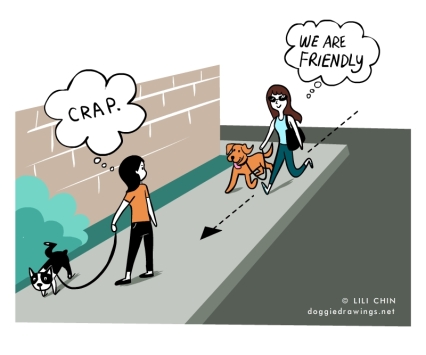
Following on from “Hair Loss and Crusty Skin”
I notice that the blog entries about Boogie’s skin issues get the MOST visits and comments compared to everything else on this blog. This “hair loss” post is many years old, and so are all the posts tagged Skin, but the comments and questions keep coming in. Lots of questions from parents of suffering dogs who want to know which remedies worked and which ones didn’t.
I don’t have answers for other people’s dogs, but here is an update for Boogie….
After spending $$$$ on vet bills, products, and visits to the dermatology clinic over the past 5 years, I decided NOT to go the path of allergy testing and lifelong injections. Our pet insurance doesn’t cover this stuff because anything skin-related is considered a “pre-existing condition”, so I have been focused on more cost-effective solutions.
2015: Boogie’s skin is not great but it is SO MUCH BETTER. In fact, over the past 12 months, Boogie’s skin has been at its best, and looks pretty good compared to previous years. The summer of 2014 was the first time in 5 years that he did not go on a long course of antibiotics and lose most of his hair. He also had no crusty bits.
The “Solution”:
- Darwin’s pet food – Beef and Veggies (I always cook the meat so it’s not 100% raw)
- Nordic Naturals Pet Cod Liver Oil
- 1 benadryl pill, crushed and mixed in food.
It took roughly 8 months before I saw the difference with Darwins food and the Pet Cod Liver Oil. Boogie’s coat became fuller and shinier; not rough and dry like before.
Benadryl was recommended by our vet. It seems extreme to be giving this to him every single day – but he is less inclined to scratch, and scratching is the FIRST STEP to infections. In warmer/itchier seasons, he gets 1 benadryl per day. In cooler seasons, he gets one every other day. He still scratches, and is still itchy… but I think it would be much worse without the benadryl.
I also bathe Boogie with Vet’s Best Allergy-Itch Relief shampoo, and occasionally soak him in a tub of diluted Vet’s Best Hot Spot Spray or I wipe him down with a cloth that I put some spray on. Especially after he has been rolling around in the grass.
Boogie still gets red and raw spots… especially on his face and in his armpits. I have found that the Virbac Resicort lotion (from our vet) helps with his armpits, but unfortunately this is a recurring problem.
P.S. I tried the coconut oil and apple cider vinegar… these didn’t do anything.
UPDATE – May 2016
This here is a really really old blog post but as I am still receiving so many comments and questions, I want to give a very quick update on Boogie’s skin problems which did in fact, repeat themselves every Summer until last year when we started him on Apoquel – an allergy medicine that does not carry the harmful effects of antibiotics or steroids or benadryl.
Boogie’s allergies were ENVIRONMENTAL, not food-related. So the grass, pollen, air, flea bites… etc.
Apoquel inhibits itching so that Boogie doesn’t feel the need to scratch – which means that his skin does not get infected (which leads to Staph infections). Boogie’s skin has cleared up and he looks great. He also has had blood work done and everything is normal. No bad side effects from the Apoquel except some weight gain.
The only problem so far with Apoquel is that it is expensive and Boogie has to take it EVERY DAY forever. When we ran out and he stopped taking it, the itchiness came back within days. It is also only available from an Animal Dermatologist. Vets have a limited supply.
The other very important life changer for Boogie is WEEKLY baths with Hexazole shampoo – this stuff is amazing. Everyone comments on how nice and shiny Boogie’s coat is. Also expensive, of course. But it works.
I am not a medical expert so don’t take my word for anything. Please talk to your vet or dermatology specialist. Hope this helps! – Lili
(Follow us on instagram HERE)
Life with a deaf dog…
- Dogs barking at him from behind fences
- Sounds of footsteps walking up behind us on the street
- The sound of buses, garbage trucks, fire trucks…
- My sneezing (Boogie used to leave the room whenever I sneezed)
- Watching youtube videos that have barking dogs in them
- Watching noisy movies
- Talking on Speaker Phone or Video Skype
- Sound of the kitchen timer when I’m cooking
- Sound of mail courier calling to me from outside the front door
- Going to the bathroom, stepping out to do laundry, emptying the trash (Boogie doesn’t wake up)
- When I come home and he’s curled up asleep oblivious that I am there.
- When I touch him gently to wake him up, and he JUMPS UP.
- When after preparing his breakfast I peek out the door and he is standing there, staring at the kitchen door, waiting for me to stick my head out the door.
- The one time I clapped my hands to call him (outdoors) and he became confused as to where the sound was coming from, became hypervigilant and started barking at everything on the street.
- When I watch old videos of Boogie and me interacting (me talking, he responding)… sometimes, I can’t help it… I start crying.
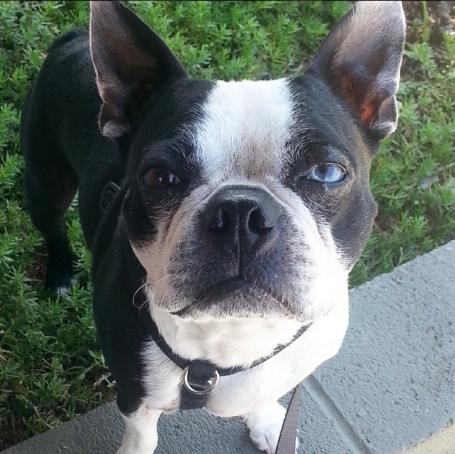
That time of year
It’s that Clicker Expo time of year and I am not going. Sigh – I will miss Sarah Owings, Emily Larlham and Susan Friedman again! Even so, my brain seems to have kicked into WANT-TO-LEARN-NEW-THINGS mode! Thank goodness for Tawzer DVD sales.
DVDs on my Watch List this week:
1. Sue Sternberg – dog-dog body language – Watching this one for drawing reference.
2. Patient Like The Chipmunks – So glad this is on YouTube! Watched this historical gem a few nights ago. Warning: Different animals doing cute amazing things but I would rate this video a zero on the ‘warm and fuzzy’ scale. 🙂 This is the cold, emotion-less face of Science, Enterprise and Efficiency in animal training… How it all began, starting with BF Skinner and pigeons shaped to guide missiles; critters in boxes performing 4-5 hour shifts…. The point is that the Brelands and Baileys are still so inspiring and deserve to be better known for being way ahead of their time in championing humane animal training methods. Quote Bob Bailey: “Patience and preparedness is better than brute force”.
3. Roger Abrantes – I have only watched Disc 1 of 3 so far and I am loving it. Quote: These DVDs are a “Review of the Principles of Behaviorism and Operant Conditioning spiced with the view of an Ethologist”. Roger Abrantes is fascinating to listen to and to observe and I think this might be the first dog training DVD I have ever watched where the presenter is actually interacting with and moving around with a dog (and their humans) rather than talking straight to camera the whole session. He also very clearly defines the words he uses. eg, Signal vs Cue vs Command; and I like that he says “Inhibitors” instead of “Punishers”.
4. Grisha Stewart – there is a full series of DVDs (with covers I illustrated!), and I am starting with the “Problem Prevention” instalment tomorrow 🙂
Will add thoughts later….
P.S. I have registered a domain name for Boogie’s blog! It is now http://www.boogiebt.com
Boogie update
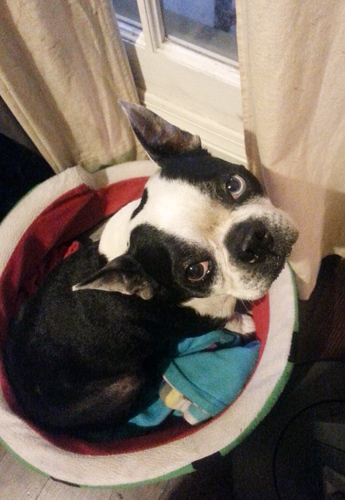
I haven’t posted on this blog in way too long. The short answer is that I have been too busy and I haven’t had anything interesting enough to spend hours writing about when it is much easier to share photos and simple one or two line Boogie updates on instagram, twitter, facebook…
Reading this article today by one of my favorite dog training bloggers made me look back in time, and look at my life with Boogie today.
You won’t know what your dog can achieve until you try. Listen to him, stay within his limits, and do not put him in situations where he struggles. Learn to read him, and work closely with a professional. Put his best interests first. Stop making excuses. If you find yourself apologizing for poor behavior using your dog’s story as an excuse, stop! Look to the dog you have in front of you right now. Read the page in front of you at this moment, not ancient history that happened weeks, months, or years ago.
I am almost tempted to title this blog post “My dog is no longer dog-reactive” but this is not entirely true.
The truth is that:
Boogie no longer reacts to dogs at a closer proximity on the street. I don’t know when I noticed the change… it has been months? Years? I really don’t know. This ‘new Boogie’ became more obvious to me recently when I noticed that OTHER dogs were reacting to Boogie and Boogie was not reacting back. I mean other dogs barking, lunging, snapping, pulling at the leash towards Boogie. And Boogie looks at them, looks at me, and moves away. It’s like a miracle. If somebody was yelling at me to F- OFF!!! on the street, it would be very hard for me to be as calm as Boogie. (I still don’t let other dogs greet him, and I only very occasionally let strange people pet him… depending on how Boogie is feeling).
What seems to happen these days:
Boogie sees a dog, turns away, continues walking. OR he sees a dog (usually bigger shepherdy type of dog), stops, looks at me ; OR he sees a dog stops, looks for a bit longer, turns around and walks the opposite direction/sniffs the ground; OR he doesn’t even appear to see the dog at all because he is focused on his destination and more interested in scavenging and foraging. The point is that he is no longer showing the signs of distress that he used to. If he shows signs of being triggered, it is less intense. He turns around to look at me, and then he bounces back. We move along.
I still bring treats on walks and I still give Boogie treats – though less frequently now, depending on his body language -when we see a strange dog/person approaching, or when we walk through triggering locations (- is there a term for this? I mean specific sections of streets where Boogie has had a history of negative associations and is more likely to freeze when he sees a person/dog… I think if he saw the same person/dog on a different street he would not care. Some triggers are definitely tied to place). If Boogie’s body language is relaxed, I let him stop and look at triggers to engage and disengage on his own and I let him choose where he wants to go.
Boogie is also 80% deaf now. He doesn’t hear many sounds except very loud or high pitched ones; he doesn’t hear other dogs barking at him, or strangers walking next to/behind us so I think he is generally less triggered by stuff. He is using his nose more. He has become obsessed with foraging. The down side is that he eats a lot of crap off the side walks and I haven’t properly taught a “leave it” or “drop it” 😦 Of course, he also doesn’t hear me call his name anymore, so I gotta do something about that.
Plugging my work (sometimes still Boogie-related!)
Or click here: http://www.doggiedrawings.net/#!mailing-list/c1ll2
There are some new things happening this month, very soon 🙂
Meanwhile, I have just signed up for Donna Hill’s online course: DOG AS A SECOND LANGUAGE. Everything I know about dog body language so far I have learned from Boogie. Yes, ONE DOG only. So much more to learn!
